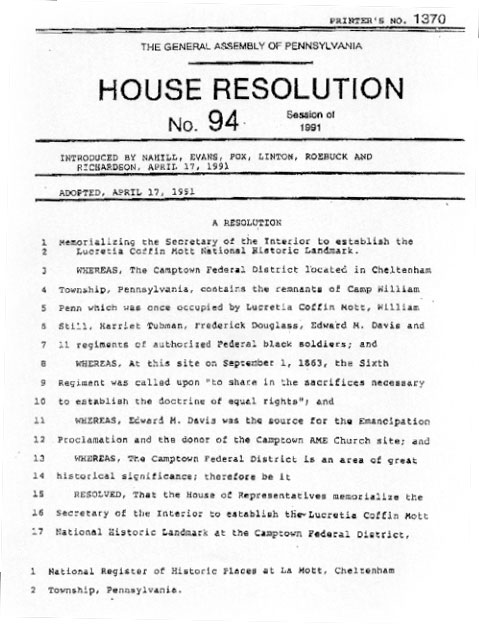La Mott Becomes Truly Historic
After years of residing in the shadows of American history, on April 23, 1974, the Hon. Lawrence Coughlin of Pennsylvania entered the following Extensions of Remarks in the Congressional Record (E 2440).
HISTORIC LA MOTT SITE OF ORGANIZATION OF FIRST FEDERAL
COLORED TROOPS
———
HON. LAWRENCE COUGHLIN
Of Pennsylvania
IN THE HOUSE OF REPRESENTATIVES
Tuesday, April 23, 1974
Mr. COUGHLIN. Mr. Speaker, I am pleased to call to the attention of my colleagues a significant celebration planned for Sunday, May 5, 1974, to commemorate the organization of the first Federal colored troops at a site which is now the community of La Mott.
Located in Cheltenham Township in Pennsylvania’s 13th Congressional District which I represent, La Mott will be honored by State, county and local officials. Among those sponsoring the event are the Pennsylvania Historical and Museum Commission, Cheltenham Historical Commission, the Township Board of Commissioners, prominent Negro leaders and local organizations.
In paying tribute to La Mott, I think it well that we reflect of the state of the Nation and its attitudes toward blacks more than a century ago. What has been accomplished and what remains to be accomplished still stand in startling contrast to the crises and attitudes of a country then rent by civil strife.
The community of La Mott, formerly known as Camp Town, was a focal point in a great debate that raged at the time of the War Between the States. After President Lincoln issued the Emancipation Proclamation, there was considerable controversy over whether or not to enlist black men in the Union Army.
Despite the furor, Secretary of War Stanton in 1863 issued an order allowing the state of Massachusetts to form the first colored regiment-the 54th Colored Regiment of the State of Massachusetts. At the same time, the War Department established a training center outside of Philadelphia where the first federally supported black soldiers were trained.
The site, now the community of La Mott, was in Chelten Hills and the training center was named Camp William Penn. Eleven regiments were trained at the camp.
Lt. Col. Louis Wagner, a veteran of the Battle of Bull Run, was the camp’s commanding officer. Black regiments mustered at Camp William Penn were the 3d, 6th, 22d, 24th, 25th, 32d, 41st, 43d, 45th and 127th. They are considered as part of the original forces of the U.S. Army. Mr. Frank H. Taylor, writing in his book, “Philadelphia in the Civil War: 1861-65,” notes that the black regiments were not credited upon the quota of the city of Philadelphia for the Commonwealth of Pennsylvania.
In his detailed book, Mr. Taylor writes of the outstanding records compiled by the enlisted men and officers. He said that 10,940 black soldiers and 400 white officers commanding them all shared in the records for bravery under fire and for efficiency in the many campaigns in which they participated. All of these men originally were assembled at Camp William Penn.
Mr. Taylor quoted the October 11, 1864, general order of Maj. Gen. Benjamin F. Butler, in which he referred to the charge of these troops at New Market:
Better men were never better led, better officers never led better men. A few more such charges and to command colored troops will be the post of honor in the American Army…
When the war ended, Camp William Penn became a home for blacks who settled at the site then referred to as Camp Town. Legend has it that they were helped to settle there by Lucretia Mott and he brother-in-law, Edward M. Davis. Both adamant abolitionists and operators of a way station along the underground railroad.
History records that blacks and immigrants of Irish descent lived side by side in harmony. La Mott grew and prospered. It remains today a friendly, stable and harmonious community where blacks and whites live together in cooperation and brotherhood.
I think it altogether fitting and proper that we take note of the La Mott celebration, both for its historic beginnings and for its present exemplification of true brotherhood. The dreams of Abraham Lincoln and Martin Luther King live in the community of La Mott.
As Congressman for the citizens of La Mott, I add my own personal congratulations on the upcoming celebration. I hope the people of LaMott know how honored I am to represent them and how delighted I am to wish them well in the years to come.
Congressional Record Online via GPO Access
http://www.access.gpo.gov/su_docs/aces/aces150.html
The Battle of Bull Run
http://www.civilwarhome.com/1manassa.htm
Taylor, Frank H. Philadelphia in the Civil War 1861-1865 – Philadelphia: 1913
National Registry of Historic Places
On October 31, 1985 the Camptown Historic District, Montgomery County became one of the sixty other recognized historic sites in Montgomery County in the Commonwealth of Pennsylvania under the provisions of the National Historic Preservation Act of 1966.
COPY OF CERTIFICATION
http://www.cr.nps.gov/nr/research/nris.htm
The General Assembly of Pennsylvania – House Resolution No. 94 – Session of 1991
On April 17, 1991, six representatives of the State of Pennsylvania introduced the resolution shown below. It was adopted on the day of introduction.
HOUSE RESOLUTION NO. 94
